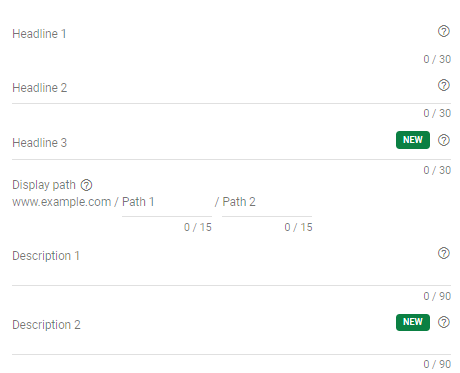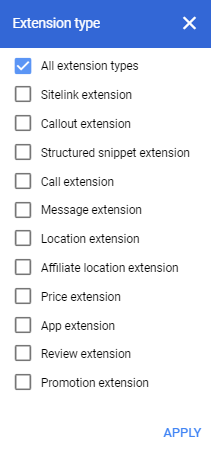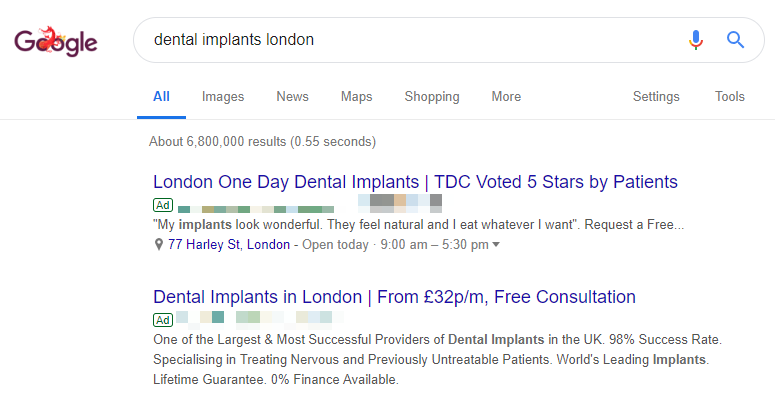
Meet
KAU Media Group's Operations Director Ben. He is responsible for strategy and extensive campaign quality control. In this blog he explains how writing the text for Google Search ads is almost always one of the last pieces of a new account set up, and should always take the most amount of time. At KMG, we continually take the time to extensively create, review and test our ad text strategy from inception and here is why...
Frequently, Ben audits accounts where competitor marketers have clearly become bored by this point and rushed through it when it is the pivotal point between a search strategy and a business's website or landing page. The relationship between the two is really important from a Google perspective
and a user perspective. KMG's Ads dominate the search engine results pages (SERPS), taking up prime real estate and getting high click through rates (CTRs) because we have a very tight relevancy strategy and understand this relationship.
Here's his run through of considerations when writing Google text Ads and winning the paid ad war:
One of the most updated elements of paid search in recent years has been ad structure, so it’s clear Google and Bing both place a lot of value in their importance. In the last 6 months we’ve seen updates to now include 3 headlines, 2 description lines, 2 paths and 11 different extension options.


Now that we have so many options in ads, a question that we marketers have to ask ourselves is, what information should we be providing consumers and where?
The only guarantees we have are that the first two out of three headlines will always show (H1 and H2) and the first description line will show (D1) (see picture 1 above).
With that in mind, these areas should be the focus of our efforts for ad content. When you combine that with the fact that internet users these days have high expectations and a low threshold for not being given what they want, H1 becomes the primary focus to grab the users attention.
How many people can honestly say that when they search for something on Google that they read all of the content within an ad? Is it not fairer to say that if the first headline meets your search requirements then you’re prepared to gamble that you’re going to find what you want once you click?
The bottom line here is that if your Headline 1 (H1) is not closely related to, or exactly matched to the users search, then the likelihood of getting a visit to your website from that user is significantly reduced.
I’d usually encourage utilising a call to action or an offer in Headline 2 (H2) as this can also differentiate your ad from the competition, thus influencing the users process in deciding which ad to click.
On the most part I believe Description 1 (D1) content to play a big part in Google’s measurement of “Ad Relevance,” so should therefore include content that is some way a repetition of the search term utilised in H1 and then some additional information linked to the website or landing page.

The ad in position 2 here, is certainly the most favourable ad and despite being one position lower, we would expect to get at least as good CTR, maybe even better. The ad relevancy is also superior and contains an offer and call to action in H2. The business in position two would almost certainly have a better keyword Quality Score (QS) than the business in position one (provided the landing content was relevant).
The theory that H1 and H2 have the most influence over user’s behaviour when it comes to clicking ads on the SERP has been proven across multiple industries and is therefore the key to successfully achieving high CTR.
At the end of the day, in almost all cases the aim of paid ads on search engines is to appear for
relevant searches and get the
highest CTR possible (unless ad copy is purposely designed to act as a gatekeeper).
Most industries on search engines these days are highly competitive, so there is an amplified necessity to drive high CTRs which will increase Quality Score, drive higher volumes of traffic at a lower cost and from lower ad positions than the competition. This ultimately increases the potential to generate more leads at a lower cost.
Although I’ve focused on H1, H2 and D1, the remaining components of ads should be also be utilised to their full potential. H3, D2 and all available extension options should be used to provide useful content, but on the most part give us marketers a chance to maximise our
Keyword -> Ad -> Landing Page relevancy in an attempt to ‘win over’ the Google Quality Score algorithm. This is critical to the Ad Relevancy component of QS. It also encourages Google to show multiple extensions, increase the real estate of your ads on the SERPs and as a bi-product have a positive influence on CTR.
If you feel your current Digital Marketing agency is letting you down, we can write you better ads, give KAU Media Group a call.
 Meet KAU Media Group's Operations Director Ben. He is responsible for strategy and extensive campaign quality control. In this blog he explains how writing the text for Google Search ads is almost always one of the last pieces of a new account set up, and should always take the most amount of time. At KMG, we continually take the time to extensively create, review and test our ad text strategy from inception and here is why...
Frequently, Ben audits accounts where competitor marketers have clearly become bored by this point and rushed through it when it is the pivotal point between a search strategy and a business's website or landing page. The relationship between the two is really important from a Google perspective and a user perspective. KMG's Ads dominate the search engine results pages (SERPS), taking up prime real estate and getting high click through rates (CTRs) because we have a very tight relevancy strategy and understand this relationship.
Here's his run through of considerations when writing Google text Ads and winning the paid ad war:
One of the most updated elements of paid search in recent years has been ad structure, so it’s clear Google and Bing both place a lot of value in their importance. In the last 6 months we’ve seen updates to now include 3 headlines, 2 description lines, 2 paths and 11 different extension options.
Meet KAU Media Group's Operations Director Ben. He is responsible for strategy and extensive campaign quality control. In this blog he explains how writing the text for Google Search ads is almost always one of the last pieces of a new account set up, and should always take the most amount of time. At KMG, we continually take the time to extensively create, review and test our ad text strategy from inception and here is why...
Frequently, Ben audits accounts where competitor marketers have clearly become bored by this point and rushed through it when it is the pivotal point between a search strategy and a business's website or landing page. The relationship between the two is really important from a Google perspective and a user perspective. KMG's Ads dominate the search engine results pages (SERPS), taking up prime real estate and getting high click through rates (CTRs) because we have a very tight relevancy strategy and understand this relationship.
Here's his run through of considerations when writing Google text Ads and winning the paid ad war:
One of the most updated elements of paid search in recent years has been ad structure, so it’s clear Google and Bing both place a lot of value in their importance. In the last 6 months we’ve seen updates to now include 3 headlines, 2 description lines, 2 paths and 11 different extension options.

 Now that we have so many options in ads, a question that we marketers have to ask ourselves is, what information should we be providing consumers and where?
The only guarantees we have are that the first two out of three headlines will always show (H1 and H2) and the first description line will show (D1) (see picture 1 above).
With that in mind, these areas should be the focus of our efforts for ad content. When you combine that with the fact that internet users these days have high expectations and a low threshold for not being given what they want, H1 becomes the primary focus to grab the users attention.
How many people can honestly say that when they search for something on Google that they read all of the content within an ad? Is it not fairer to say that if the first headline meets your search requirements then you’re prepared to gamble that you’re going to find what you want once you click?
The bottom line here is that if your Headline 1 (H1) is not closely related to, or exactly matched to the users search, then the likelihood of getting a visit to your website from that user is significantly reduced.
I’d usually encourage utilising a call to action or an offer in Headline 2 (H2) as this can also differentiate your ad from the competition, thus influencing the users process in deciding which ad to click.
On the most part I believe Description 1 (D1) content to play a big part in Google’s measurement of “Ad Relevance,” so should therefore include content that is some way a repetition of the search term utilised in H1 and then some additional information linked to the website or landing page.
Now that we have so many options in ads, a question that we marketers have to ask ourselves is, what information should we be providing consumers and where?
The only guarantees we have are that the first two out of three headlines will always show (H1 and H2) and the first description line will show (D1) (see picture 1 above).
With that in mind, these areas should be the focus of our efforts for ad content. When you combine that with the fact that internet users these days have high expectations and a low threshold for not being given what they want, H1 becomes the primary focus to grab the users attention.
How many people can honestly say that when they search for something on Google that they read all of the content within an ad? Is it not fairer to say that if the first headline meets your search requirements then you’re prepared to gamble that you’re going to find what you want once you click?
The bottom line here is that if your Headline 1 (H1) is not closely related to, or exactly matched to the users search, then the likelihood of getting a visit to your website from that user is significantly reduced.
I’d usually encourage utilising a call to action or an offer in Headline 2 (H2) as this can also differentiate your ad from the competition, thus influencing the users process in deciding which ad to click.
On the most part I believe Description 1 (D1) content to play a big part in Google’s measurement of “Ad Relevance,” so should therefore include content that is some way a repetition of the search term utilised in H1 and then some additional information linked to the website or landing page.
 The ad in position 2 here, is certainly the most favourable ad and despite being one position lower, we would expect to get at least as good CTR, maybe even better. The ad relevancy is also superior and contains an offer and call to action in H2. The business in position two would almost certainly have a better keyword Quality Score (QS) than the business in position one (provided the landing content was relevant).
The theory that H1 and H2 have the most influence over user’s behaviour when it comes to clicking ads on the SERP has been proven across multiple industries and is therefore the key to successfully achieving high CTR.
At the end of the day, in almost all cases the aim of paid ads on search engines is to appear for relevant searches and get the highest CTR possible (unless ad copy is purposely designed to act as a gatekeeper).
Most industries on search engines these days are highly competitive, so there is an amplified necessity to drive high CTRs which will increase Quality Score, drive higher volumes of traffic at a lower cost and from lower ad positions than the competition. This ultimately increases the potential to generate more leads at a lower cost.
Although I’ve focused on H1, H2 and D1, the remaining components of ads should be also be utilised to their full potential. H3, D2 and all available extension options should be used to provide useful content, but on the most part give us marketers a chance to maximise our Keyword -> Ad -> Landing Page relevancy in an attempt to ‘win over’ the Google Quality Score algorithm. This is critical to the Ad Relevancy component of QS. It also encourages Google to show multiple extensions, increase the real estate of your ads on the SERPs and as a bi-product have a positive influence on CTR.
If you feel your current Digital Marketing agency is letting you down, we can write you better ads, give KAU Media Group a call.
The ad in position 2 here, is certainly the most favourable ad and despite being one position lower, we would expect to get at least as good CTR, maybe even better. The ad relevancy is also superior and contains an offer and call to action in H2. The business in position two would almost certainly have a better keyword Quality Score (QS) than the business in position one (provided the landing content was relevant).
The theory that H1 and H2 have the most influence over user’s behaviour when it comes to clicking ads on the SERP has been proven across multiple industries and is therefore the key to successfully achieving high CTR.
At the end of the day, in almost all cases the aim of paid ads on search engines is to appear for relevant searches and get the highest CTR possible (unless ad copy is purposely designed to act as a gatekeeper).
Most industries on search engines these days are highly competitive, so there is an amplified necessity to drive high CTRs which will increase Quality Score, drive higher volumes of traffic at a lower cost and from lower ad positions than the competition. This ultimately increases the potential to generate more leads at a lower cost.
Although I’ve focused on H1, H2 and D1, the remaining components of ads should be also be utilised to their full potential. H3, D2 and all available extension options should be used to provide useful content, but on the most part give us marketers a chance to maximise our Keyword -> Ad -> Landing Page relevancy in an attempt to ‘win over’ the Google Quality Score algorithm. This is critical to the Ad Relevancy component of QS. It also encourages Google to show multiple extensions, increase the real estate of your ads on the SERPs and as a bi-product have a positive influence on CTR.
If you feel your current Digital Marketing agency is letting you down, we can write you better ads, give KAU Media Group a call.